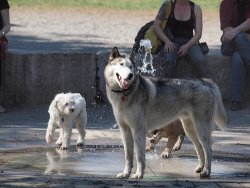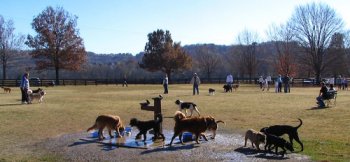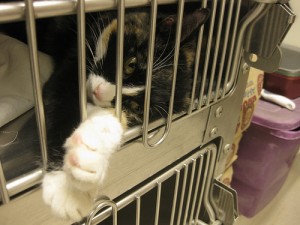Should I Choose a Dog or a Cat as a Pet?
June 13, 2010 by LaBecs
Filed under Should I choose a dog or a cat as a pet?
You want to adopt a pet, but how do you decide if you want a dog or a cat? Well, the obvious answer lies within you: are you a “dog person”, or a “cat person”? Most people already know this, but if you really never thought about it, let’s see what advantages or disadvantages each species has to help you decide.
Cats and dogs have different needs and characteristics. One thing that applies to both is that they all need attention, you need to budget for their veterinary care, food and emergencies, you need to clean after them, and you have to love them unconditionally.
Now, for the differences.
Dogs:
Your lifestyle will definitely determine if you should have a dog or a cat as a pet. If you like to travel a lot, or work all day, a dog is not for you.
-Different breeds have different characteristics, you should choose one that matches your personality and lifestyle.
-If you travel, boarding a dog is quite expensive.
-A dog needs company and attention. If you have a dog and leave him home alone all day, you will have a very unhappy pet.
-Dogs need exercise. More or less depending on the breed.
-You need to walk them at least a couple of times daily for them to do “their thing”.
-Dogs need to be trained, socialized and housebroken.
-Dogs like to play. They need to be stimulated and love to play with their masters.
-Some dogs shed a lot. You have to be prepared to clean after them constantly.
 -Dogs need to be groomed often. You need to brush their coat, bathe them, and brush their teeth.
-Dogs need to be groomed often. You need to brush their coat, bathe them, and brush their teeth.
-A small dog is a little easier to take care of, but it still needs walks, play and attention. A big dog obviously needs more space.
-A small dog eats very little, but a big dog will eat a lot. You have to be ready for the expense of feeding.
-Dogs love to ride in the car and go hiking, swimming and all kinds of outdoor activities.
-A dog will greet you happily every time you come home, he will want to sleep with you, and in general, share everything with you.
-There are many dog parks where you can take your pet to run and play.
-Dogs are protective of their humans and will be faithful forever.
Cats:
If you work outside your home or travel a lot, and the pet needs to be alone for many ours, a cat might be for you.
-If you travel, boarding a cat is not as expensive, depending on the facility. They could be left at home with a pet sitter visiting once or twice a day.
-All cats have different personalities. Some are affectionate lap cats, and others are more energetic and don’t like to be petted as much. Choose carefully.
-A cat can be left alone to sleep most of the day.
-Cats are independent, but that does not mean you can live them alone all day and not pay any attention to them. They do love company.
 -Cats need to play and be stimulated. They entertain themselves more easily without being destructive.
-Cats need to play and be stimulated. They entertain themselves more easily without being destructive.
-Cats are very easily trained to use their litter box, which requires cleaning at least once a day.
-There’s no need to walk them, though some cats like to walk on a leash.
-Some cats are easily trained to do tricks. Some are very good at fetching.
-Cats eat very little depending on their size, but never as much as a dog.
-Cats don’t need to be bathed, but they do need to get brushed and you need to brush their teeth regularly.
-You can get a cat used to car rides, but they mostly prefer to stay at home.
-Cats can live in small apartments. It’s actually better to always keep them indoors.
-Contrary to popular belief, cats will greet you at the door and follow you around like a dog.
-Cats are playful and a delight to watch as they jump and run and chase.
-You need to have space for a litter box in a well ventilated area, away from kids and out of site.
-Cats like to have scratching posts or kitty condos.
-Cats love to cuddle.
-Cats can be very protective of their humans and will be faithful forever. They do get attached to their owners.
I am one of those strange people that is a cat person and a dog person. I love them both with all my heart and enjoy their different personality traits. I have never had two cats with the same personality, it’s always an adventure to get to know them. And dogs for me, are the best company you can ever ask for. But one thing is certain, both species are incredible, and everybody should have the experience of living with one or both of them at some point.
Chihuahuas
February 17, 2010 by LaBecs
Filed under Chihuahuas
1.- There are two kinds of Chihuahuas: Apple head, with a short nose and round head, and Deer head, with a more elongated face.
 2.- They come long haired or short haired. The short haired has a smooth coat and sheds minimally. The long haired Chihuahua’s coat is silky, curly or flat.
2.- They come long haired or short haired. The short haired has a smooth coat and sheds minimally. The long haired Chihuahua’s coat is silky, curly or flat.
3.- They come in many colors: sand, black, fawn, white, black and white… and more.
4.- They are the tiniest dog breed.
5.- They do better with solid, dry food. Soft and canned food can promote dental problems.
6.- They are highly intelligent and can be hard to train. They require firm and gentle leadership.
7.- They gain weight easily, which can be very harmful to their health.
8.- They look very active at home, but that should not take the place of a good walk. When they are not walked often, they can present behavior problems.
9.- They can live from 14 to 19 years.
10.- They like to form ‘”clans” and will get along better with other Chihuahuas than other breeds.
They need to be very well socialized. If you allow them to be the pack leader, they’ll become possessive and even aggressive towards strangers. They can also be aggressive towards other dogs.
Though they are cute and tiny, they are not recommended for children.
Their temperament depends totally on how the owners treat them. If the owners are overly protective and baby them too much (which is the tendency) they will not be trustworthy pets. They can even become obnoxious.
Shelters tend to have large amounts of Chihuahuas. People tend to abandon them when they realize they are not the “toys” they hoped they would be. They represent a big responsibility.
Yes, their name comes from the Mexican State of Chihuahua, where they were discovered, but they date as far back as the 9th century AD and were found in the Aztec capital.
Long Haired Chihuahua Photo Courtesy of: Phoenix wolf-ray
Apple Head Chihuahua courtesy of: blackdood
Socializing Your Puppy or Dog
June 1, 2009 by LaBecs
Filed under Socializing Your Puppy or Dog
When you have a child, you have a responsibility to introduce him or her to a wide range of people and experiences to better prepare them for the world. The same is true when you have a puppy or a dog. This process is known as socialization. Let’s look at some of the reasons why this process is so important and how you can be sure to properly socialize your canine companion.
Good Reasons to Socialize
If you’ve seen aggressive dogs before, you’ve also seen the consequences of poor socialization. When dogs haven’t been introduced to these new experiences, they become fearful and anxious when encountering them. Just think of how you felt on the very first day you ever worked at a job or the first day you went to school.
Socialization, therefore, helps make dogs more comfortable when they have these experiences, such as meeting a new dog at the pet store or being petted by children or riding in the car. Positive early experiences are the best way to prevent future anxiety and aggression problems in your dog.
Another good thing about socialization is it helps you meet new people and have new experiences. Taking your dog to the park, for example, is a great way to start up conversations with people if you are normally a shy person.
Methods of Socialization
Obviously, the best time to start is when the puppy is very young. Take him or her with you whenever you can, and let people approach and pet him. Take him to the puppy education classes of your local pet shop where he will interact with other puppies. Take him to the small dog area of your local dog park. See how he reacts, how he acts, and get to know him well.
If you adopted an adult dog, hopefully he will have been exposed to other people and dogs in positive situations, but you still have to see for yourself how he reacts around people and animals.

The most important part of the socialization process is the positive experience. If you take your dog to the dog park for the first time and the experience is horrible, she is going to be more reluctant to return the second time. She may be fearful or anxious which could lead to another bad experience. Before you know it, the dog park is off limits. You obviously don’t want that to happen.
So, take her at a time when there are not a lot of dogs around. Don’t bring her in with the leash on. By now you should know how she reacts to other dogs she might have encountered on her walks. If she tends to be aggressive, you might need to do some training before exposing her to a large dog park. How can you guarantee a positive experience? Remove your own fear and nervousness about the situation. If you’re nervous, your dog will be, too. Always be positive and assume that the experience is going to go well.
Another way to do it is taking him to the pet shop, where she or he will probably encounter other dogs. When you go to the pet store, keep your dog on leash at all times (and do not use extensible leashes) and pay attention to his or her behavior. A dog that starts acting nervous or becomes very alert needs to be corrected immediately.
If your dog becomes nervous under certain circumstances, it’s a good idea to calmly make him or her confront what is causing the nervousness… unless it is a real threat. If you’re walking your dog on the sidewalk and a city bus drives by and startles your dog, the next time a bus comes, make him sit instead of letting him hide from it. Have him sit until the bus passes and then praise him like crazy. Now, if an unleashed, threatening dog were approaching you, this would require a different tactic and would not be the best time to confront the problem.
The important thing is to have your dog encounter as many new experiences and people as possible. Walk him or her in different locations: your neighborhood, the park, the river, around shopping areas that permit dogs, near roads, around noisy areas, and around quiet areas. You also want your dog to interact with other animals and people, including people of all types and ages. Make sure your dog is also socialized to lots of experiences, including riding in the car, having his feet touched, being groomed, getting a bath, being petted, and more.
The bottom line is that thorough socialization does take time and commitment from you, but the results are well worth the effort.
The Awful Reality of Puppy Mills
June 1, 2009 by LaBecs
Filed under The Awful Reality of Puppy Mills
You’ve probably heard about puppy mills. But did you know that if you purchase a dog from a pet store and many of the breeders online or in the newspaper, you could be helping keep the puppy mill industry afloat?
Most people don’t realize where those dogs who suffer so much end up. They often don’t even know how much suffering the dogs have to endure. Below is some information you should read before you decide how to find your new canine companion.
The Abuses of Puppy Mills
If you’re not familiar with the term “puppy mill”, you may want to learn about them before you start looking around for your new puppy or dog. Basically, puppy mills operate like factories to produce new offspring that can be sold.
Female dogs are bred from their first heat cycle and again each time until they are no long able to reproduce. Then they are “disposed of.” The puppies are kept with their mothers in tiny cages, usually stacked on top of one another in cramped and dirty environments. Because the cages are made from wire, the excrement and urine from the above dogs can fall down onto the lower dogs. The wire cages also cause foot injuries and are very uncomfortable.

A Living Hell
Most of the dogs are underfed. Most have worms because of their close quarters and their unhygienic environment. Fleas and mites are huge problems because most of these puppy mills are located in the country and none of them receive any type of preventative care. Some even contract heart worms and other serious illnesses. They also tend to have emotional problems because they lack any human contact during their formative years, and because their mothers are usually too weak to give them much compassion.
In some of the worst of these places, dead dogs are left in the cages to decompose with the living ones.
Where the Puppies Go
As you can imagine, most “hell operators”, as I like to call them, do not sell their “stock” from their factory. Instead, they have other ways of connecting with potential customers. Pet shops are one of the largest buyers. Most of the dogs you see being sold in pet stores for hundreds of dollars were bought for a fraction of that from puppy mills. However, since the puppy mills sell hundreds of dogs every couple of months, they are profiting from these sales in major ways.
But pet stores are only one method. Many of the breeders who advertise online and in the newspaper are also puppy mills themselves or are selling supplies of dogs they have gotten from puppy mills.
What you get is a puppy facing an array of immediate medical problems and with genetic diseases that will surface years later.
Signs of a Puppy Mill
Regardless of what pet stores may say, their supply of dogs comes from puppy mills. However, with breeders, you may have a harder time recognizing the possibilities. To protect yourself, always ask to visit the puppies on-site so you can view the condition of the mother and possibly the father. For obvious reasons, if you are buying directly from a puppy mill, they will have some excuse as to why you cannot do this.
If you do arrive on-site but are not allowed to see the mother of the puppies, this is also a sign the puppies may be from a puppy mill and that the mother may be another location altogether.
Never buy a puppy without seeing where they and their parents are raised and housed with your own eyes. Do your research; get references about breeders in your area.
While your heart may go out to these suffering puppies, when you buy them from these sources you’re only contributing to the problem and continuing the puppy mill business. That’s why I always urge and encourage people to adopt either from a humane society, a rescue, or a shelter, and help put those torture chambers out of business for good.
The Benefits of Using a Dog Park
May 27, 2009 by LaBecs
Filed under The Benefits of Using a Dog Park
Dogs of all ages need exercise. Nothing can replace a good walk with a human companion, but all dogs really want a chance to run and really stretch their legs. If they can enjoy the camaraderie of other canines at the same time, that’s even better. And that’s why dog parks are such a great place for your pets.
Let’s look at some of the good reasons to use your local dog park, as well as a few precautions you should be taking, too.
Socialization Galore
If you’re fortunate enough to have a popular dog park in your community, this can be a great source of socialization for your dog. Dogs need to have as many interactions as possible with other dogs and with humans so they will feel comfortable in lots of different situations. A well-socialized dog is less likely to be anxious, nervous, or aggressive. Because a dog park is full of people and pets, socialization is almost guaranteed.
Fun for Dogs of All Types
Dogs love to walk and explore their environment, but they may not always like having to be leashed in the process. Even if you have a big fenced in yard where your dog can run safely unleashed, if he or she doesn’t have a buddy to chase around the fun may be limited. At the dog park, dogs can do their own thing off-leash. Older dogs might just want to find a shady spot under a tree. Active dogs may want to play as a pack. Some dogs may want to play fetch with their human companions.
If you’ve never seen the pure look of happiness on the face of a dog running off-leash, you need to head to the nearest dog park and see it for yourself.
Healthy Exercise
Another benefit is the exercise for your dog. Dogs who don’t get enough exercise are prone to obesity, arthritis, and other serious health problems. Plus, they are more difficult to live with because all of the pent up energy is going to emerge as destructive, unwanted behavior in your home.
While walking your dog is good exercise for both of you, the dog park is going to give your dog a chance to really get a workout and drain that energy. Regular visits to the dog park will make a huge difference in even the feistiest dog.

A Few Precautions
Dog parks clearly have a lot of benefits, but you do need to take some precautions for your pet’s protection and your own.
1. Separate Small and Large Dogs – Most dog parks have separate areas so small dogs can enjoy themselves safely. Large dogs, even the friendly ones, can accidentally injure a small dog. Obey the rules on separation by size, and if your particular park does not offer that option, start campaigning in order to have the city establish it.
2. Look Around – Always keep an eye out for dog fights, which will undoubtedly happen once in a while. If you know the park well, be aware of new dogs coming into the park and their general demeanor.
3. Keep Your Dog Under Vocal Control – Even though the dog park is a place where humans can mingle, too, you don’t want to become so distracted in your conversation that you can’t pay attention to what your dog is doing. Most dog parks do have rules requiring you to have vocal control over your dog at all times.
4. Keep Your Eyes Open – The dog park will give you a chance to socialize with other dog owners, however, always keep your dog in sight. Be aware of other dogs getting aggressive, or even of what he get’s into his mouth. One of the ways to keep the parks pleasant, is for the owners to always pick up after their dogs. Don’t be so distracted that you don’t see when your dog does its business.
5. Bring Water – Although some dog parks do have the ability to provide water for the dogs through a fountain, most do not. Always bring along water for your dogs because the can easily get overheated when they’re playing in the warm sunshine. In the summer, you might find the best times to play are in the morning and in the evening before sunset.
6. Protect Yourself – Getting to know your fellow dog lovers is a great idea but you have to be careful. Just because someone owns a dog that doesn’t mean they are a wonderful person. Be careful about how much personal information you reveal about yourself. Do not leave your purse or wallet visible in the car while you are inside the park. Would be thief knows you’ll be distracted and will take advantage of the fact.
Most importantly, use this play time to bond with your dog. Don’t just get there and ignore him or her the rest of the time. Nothing will make your dog happier, than having the chance to play with you.
Top 12 Friendliest Dogs
April 24, 2009 by LaBecs
Filed under Friendliest Dogs
When you decide to bring a new dog into your life, it helps to know its temperament, what’s the breed’s normal behavior, what are its characteristics, etc. Some dogs are great for kids, when some others are better suited for athletic grown ups, and yet others are better with elderly people. But, which breeds make the friendliest dogs? Some breeds are friendlier by nature than others, that’s not to say that a dog’s temperament cannot be greatly dependent on the owner’s behavior and lifestyle. It also doesn’t mean that if the breed tends to be friendly, it’s automatically an appropriate breed for all people. To help you do your homework, here’s a list of the top 12 friendliest dogs around.
Click on the pictures to learn more!
 #12 #12Brittany Spaniel |
 #11 #11Japanese Chin |
||||||||
 #10 #10Vizla |
 #9 #9Springer Spaniel |
||||||||
 #8 #8Cavalier King Charles |
 #7 #7Papillon |
||||||||
|
|||||||||
CLICK HERE TO SEE THE FRIENDLIEST CATS…
Photo credits:
Adopting from an Animal Shelter
March 13, 2009 by LaBecs
Filed under Adopting From an Animal Shelter
Animal shelters from your local Humane Society are your best source when looking for a cat or a dog to bring into your family. Not only do they have a great selection of adult animals for adoption, but they also have kittens and puppies, even purebred animals. On average, purebreds account for about 25 to 30 percent of a shelter’s dog population. So before you look for a dog or a cat for sale, go to the American Humane Society, and take the steps to adopt a dog, or a cat that really needs a home.
Many pets at your local shelter are waiting for new homes because they were obtained by someone with unrealistic expectations of the time, effort, and money required to sustain a lifelong relationship with their pet. National figures indicate that about half of the animals in shelters must be euthanized for lack of homes. Animals at your local shelter are eager to find a new home and are just waiting for someone like you.
You can depend on responsible shelters to assess the animals’ health and temperament in order to make the best adoption matches possible. When animals are relinquished by owners, the shelter staff makes every attempt to collect a thorough history of that pet. Then, while caring for animals, staff and volunteers try to learn as much as they can about these animals as well as those who come to the shelter as strays.
Don’t be discouraged if, when you first visit the shelter, there are no animals of the breed or type you want. Shelters receive new animals every day.
 Your shelter may also have a waiting list and can call you when an animal matching your preference becomes
Your shelter may also have a waiting list and can call you when an animal matching your preference becomes  available. Before choosing your pet, you can even speak with an adoption counselor about whether your choice of a particular type or breed will be best for you. In an effort to make good matches between people and animals and to place pets in lifelong homes, many shelters provide adoption counseling and follow-up assistance, such as pet parenting and dog-training classes, medical services, and behavior counseling. Or they may be able to refer you to providers of these services.
available. Before choosing your pet, you can even speak with an adoption counselor about whether your choice of a particular type or breed will be best for you. In an effort to make good matches between people and animals and to place pets in lifelong homes, many shelters provide adoption counseling and follow-up assistance, such as pet parenting and dog-training classes, medical services, and behavior counseling. Or they may be able to refer you to providers of these services.
Another advantage is that shelter adoption fees are usually much less than an animal’s purchase price at a pet store or breeder. And your new pet is more likely to be vaccinated, dewormed, and spayed or neutered.
To locate your local animal shelter, check the Yellow Pages under “animal shelter,” “animal control,” or “humane society.” Many shelters have websites on which they display the animals they have available for adoption. Some sites allow you to download adoption forms and read about responsible pet care. |
A growing number of shelters also promote their web sites, and the animals they have for adoption, on sites such as Pets 911, Petfinder, and 1-800-Save-A-Pet.com.
Reprinted by permission of The Humane Society of the United States



 #6
#6 #5
#5

 #2
#2 #1
#1